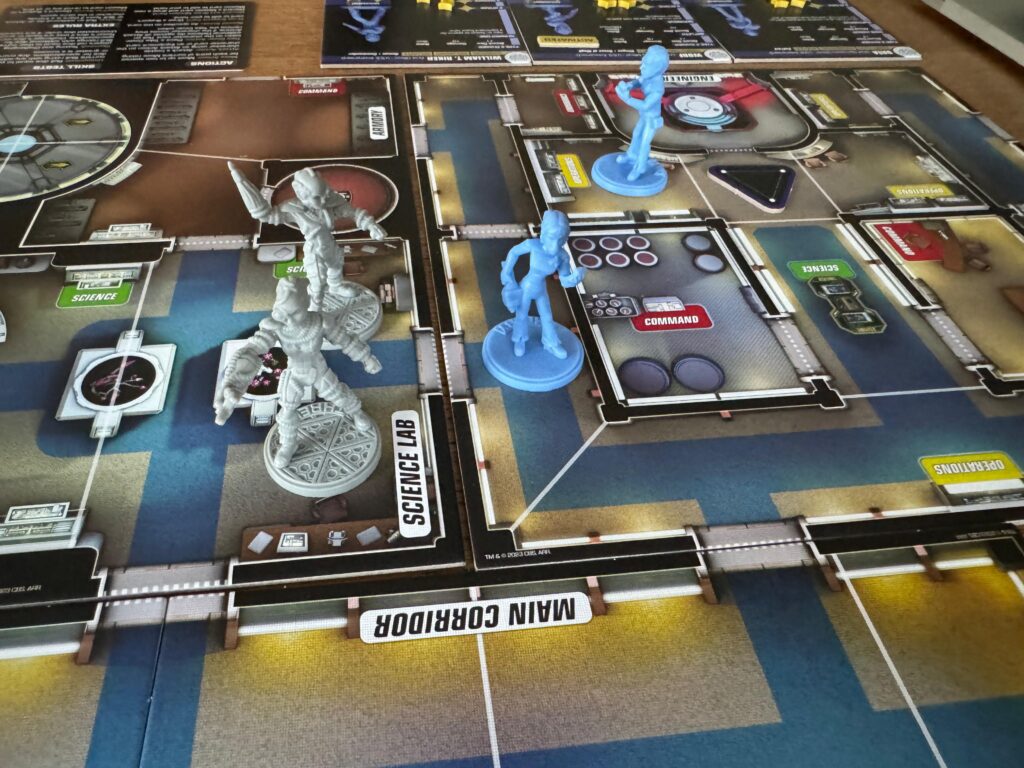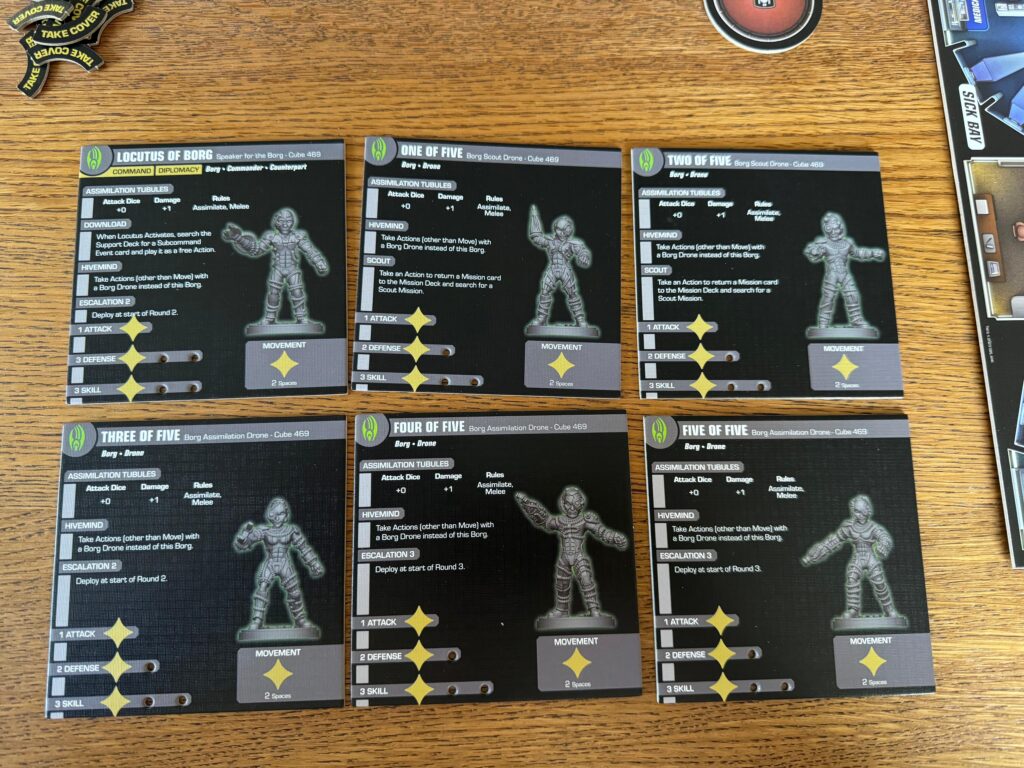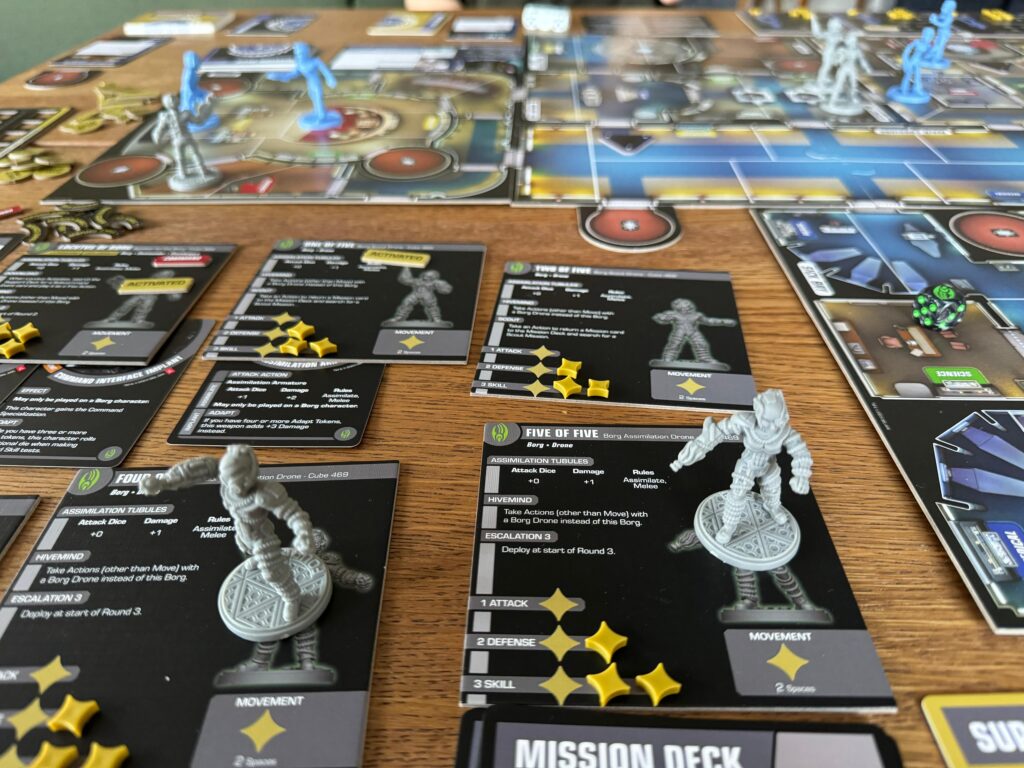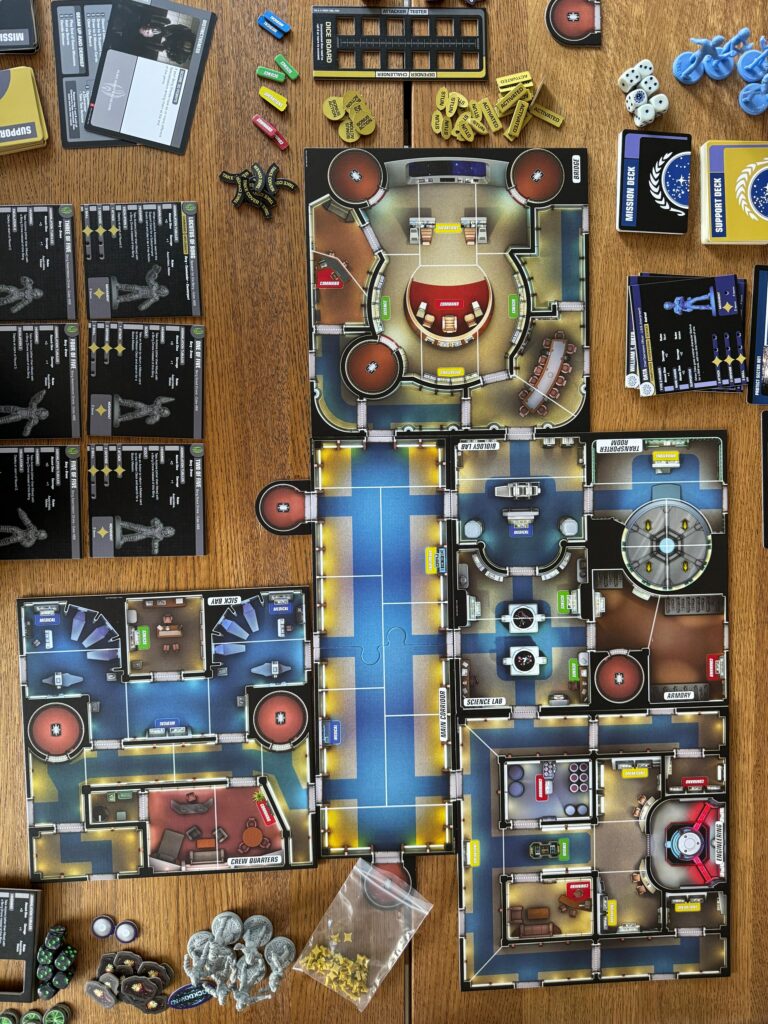Set phasers to fun in Star Trek: Away Missions – Battle of Wolf 359 (from GF9)! Captain Picard has disappeared in a conflict with the dangerous Borg: cyborgs who want to assimilate everything and everyone. Now the Borg are threatening humanity’s home planet, Earth! Assemble your mission team and go into battle. Will you draw the line here and no further, or is resistance futile?
Previously on… Star Trek: The Next Generation
First some background for the non-Trekkies in our midst. So the board game is set in the Star Trek universe, at the end of the 24th century. Humanity has solved its own problems (poverty gone! no more climate change! money obsolete!) and has now been traveling among the stars for a few hundred years. As it turns out, we are not alone in the universe. After some fuss and bother, many aliens (including us) are members of the United Federation of Planets. Part of the “Federation” is Starfleet, a peace-loving but non-naive fleet full of space explorers. Starfleet’s flagship at the end of the 24th century is the USS 1701-D, the “Enterprise,” version D. Her ongoing mission? Discovering strange new worlds, seeking out new life and new civilizations, and bravely going where no one has gone before.


You can see the adventures of the Enterprise-D in the fantastic series Star Trek: The Next Generation (on Netflix in the Netherlands). Start at season 2 and watch 1 back later. Some of the starship crew members, who you may know through cultural osmosis, also appear in this board game:
- Captain Picard, a down-to-earth captain who has his crew’s best interests at heart, an adventurous edge and has been playing the recorder for a hundred years (long story, good episode);
- Commander Riker, the tall bearded first officer and ladies’ man, who goes through fire for everyone and fell in love with a non-binary alien back in the 1990s (fun episode, good punchline);
- Lieutenant-Commander Data, an android who, like Pinoccio, wants to become a real boy and turns out to be a very good jazz and blues singer (Star Trek Nemesis, bad movie but a guilty pleasure of mine);
- Lieutenant Worf, the Klingon security officer of the Enterprise with a great sense of honor and a purple space bazooka (don’t ask); and
- Commander Shelby, a character who is only in the series very briefly and is especially relevant as a Board expert in the episode on which this board game is based. Totally fun, of course, but then I would have preferred Doctor Crusher or Chief Engineer LaForge on my team. At least it is episode-accurate.
On the other hand, you have the Borg, the cyborgs who assimilate beings, taking all the knowledge and abilities into their collective. With their hivemind, they act as one and adapt to enemies’ tactics and weapons at lightning speed. The main Borg in this board game is Locutus or Borg (“he who speaks,” in potty Latin). Locutus is the most dangerous of them all, with a lot of knowledge about the Federation and the Enterprise-D in particular… (I’ll leave out a 30-plus-year-old spoiler).


The board game is set during the season finale of the third season of the TV series, during the famous “Battle of Wolf 395” – in the Wolf system a few light years away from Earth. The Borg have launched a major offensive against the Federation and want to assimilate the Federation’s “capital” (Earth) first. Captain Picard has been kidnapped by the Borg and nowhere to be seen… where is he ver-borg-en? You’ll find out for yourself. Commander Riker along with Data, Worf and Shelby in the form of an “away team” must go out to fight the Borg. The Borg, on the other hand, are busy assimilating the Enterprise.
Okay, but how is the game played?
The rules are actually quite simple. Each player chooses a team (Federation or Borg), one of the few main missions and assembles their own stick of cards. Then the players together lay out the game board. Does the mission take place in familiar locations of the Enterprise, or in the many corners of the Borg Cube (yes yes, the Borg travel through space in a cube, how cool is that!?). Then players take turns tactically placing their away team’s miniatures on the board and the game can begin.
The game plays in three rounds, each consisting of drawing mission cards and support cards. Mission cards earn you points, support cards provide useful tricks or reinforcing gear for your away team. In three rounds, teams must compete against each other to complete mission cards and the main mission. Each player has two actions per character, which consist of moving, taking cover, playing cards or fighting. Combat, like risk, takes place with the deployment of dice, the amount of dice depends on the strength of your character and his support. The player with the fewest characters in the game gets bonus actions at the beginning of the round. The one with the most points wins the game and crows victory over the Alpha Quadrant!
Each team plays different. For example, the Federation is very mobile and can run around and transport quickly, while the Borg are slower but with more characters. The Federation “shoots” with more dice, while the Borg throw fewer dice but do more damage áf they hit. The Federation also has the ‘stun’ setting on, and can only kill after it has played an action before. So the teams and dynamics are very different with each other.


Star Trek Away Missions real secret is the fact that you can buy many different collectible packs. Expansions with additional away teams and characters. So you can also buy the Romulans and the Klingons additionally (two well-known aliens from the Star Trek universe) or back in time with Captain Kirk and Engineer Scotty (from the first Star Trek series of the 1960s). So you can vary more and move different adventures. Less Borg, more Tribbles!
Infinite fun without a Bat’leth breathing down your neck
Star Trek Away Missions is a fun and tactical game that thematically oozes ‘nineties Star Trek.’ With fun shots from the series, a background of the story in the manual and maps and descriptions that are fodder for the seasoned fan. The real replayability is ultimately in the expansions, so know what you’re buying (read: more expansions). Play long and prosper!



